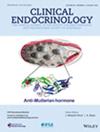Clinical Significance of Skeletal Fat-to-Muscle Ratio in Idiopathic Hyperaldosteronism
Abstract
Objective
The objective of this study is to evaluate the correlation between the fat-to-muscle ratio (FMR) and insulin resistance (IR) with aldosterone production among patients with idiopathic hyperaldosteronism (IHA).
Methods
Patients with primary aldosteronism were screened from those with secondary hypertension and then subtyped via adrenal venous sampling. A total of 199 patients with IHA and 186 with essential hypertension (EH) (controls) were studied. Baseline clinical characteristics, including data on diabetes and IHA, were collected. The FMR was evaluated based on the distribution of adipose tissue and muscle, measured by a body composition analyzer.
Results
The prevalence of diabetes and prediabetes was significantly higher in patients with IHA compared to those with essential hypertension. IHA patients also had significantly higher hemoglobin A1c(HbA1c) levels, homeostatic model assessment of insulin resistance (HOMA-IR), and much lower quantitative insulin sensitivity check index scores than the EH group. FMR was positively associated with fasting insulin, HOMA-IR, aldosterone-to-renin ratio (ARR), and age. A higher FMR was linked to the prevalence of IHA, with a stepwise increase in risk observed from the lowest to the highest quartiles of FMR. Logistic regression analysis showed that both HOMA-IR and body mass index contributed to the elevated FMR. IHA may result from a substantial loss of muscle mass accompanied by fat accumulation.
Discussion
In this retrospective study, our findings suggest that FMR could serve as a valuable metric for early intervention and comanagement strategies in patients at risk of sarcopenic obesity. This approach could help block the progression from aldosterone-producing cell clusters to IHA, potentially inhibiting aldosterone overproduction in such patients.

 求助内容:
求助内容: 应助结果提醒方式:
应助结果提醒方式:


